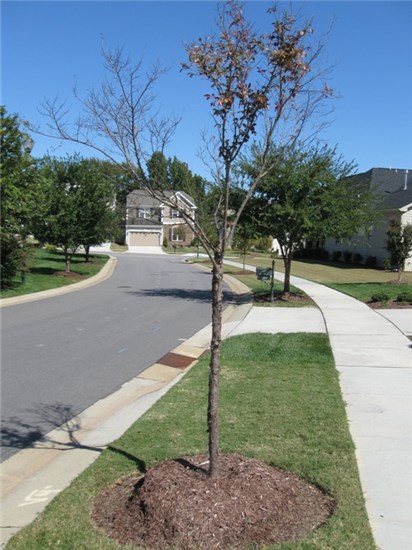 The Urban Forestry Division is charged with the replacement of trees that have been removed from public rights-of-way and street tree easements, as well as identify vacant planting locations for future planting.
The Urban Forestry Division is charged with the replacement of trees that have been removed from public rights-of-way and street tree easements, as well as identify vacant planting locations for future planting.
Trees provide many benefits, from cooling and shading our homes to increasing property values, even enhancing our mental health. For this reason, the Town of Wake Forest requires street trees to be planted in all new developments. This requirement helps to ensure that Wake Forest remains a community of tree-lined streets with a unified streetscape that provides visual interest to pedestrians and motorists.
In new subdivision developments, the developer is responsible for planting street trees within the public right-of-way, or within a dedicated street tree easement, which is granted to the Town for the purpose of maintaining the trees. After the trees are planted, the Urban Forestry Division conducts a landscape inspection to ensure the trees are planted per the approved development plan. If the inspection passes approval, the developer is granted a one-year warranty for all street trees within the development. During this timeframe, the developer maintains responsibility for care, maintenance, and replacement of trees. At the end of the one-year warranty, the Urban Forestry Division will conduct another inspection, and if everything meets approval, the Town will then assume responsibility for the care and maintenance of the street trees.
Tree Planting & Replacement Process
Town-maintained trees are replaced on a first-come, first-served basis. The Urban Forestry Division is typically notified by a resident that their street tree has died and is requesting the tree to be removed and replaced. At other times, Urban Forestry staff may notice a dead tree during routine inspections and add it to the database. All tree service requests are documented in a database listed by date of notification.
As dead trees are removed and stumps are ground, the address for the tree is added to the planting list, again using the initial date of notification to maintain priority order. In some cases, if the Urban Forestry Division believes the tree may be replaced during the next planting cycle, the stump may be left as a visual marker for the landscape contractor. It is also more cost effective to have the landscaper pull a small stump versus the tree maintenance contractor grinding it.
Per Town policy, the tree planting season begins October 1 and ends March 31. Planting during the fall and winter ensures the tree's root system has time to acclimate before spring leaf-out and summer heat. The number of trees planted each season is limited to the amount budgeted for tree planting and the landscape contractor's bid amount. The Urban Forestry Division strives to plant as many trees as possible given these constraints.
Unified Development Ordinance
The Wake Forest Unified Development Ordinance (UDO) combines into a single document the town's zoning, subdivision, land use, grading, storm water management, and historic preservation regulations. Chapter 8 of the UDO specifically addresses issues related to Urban Forestry, including tree protection, buffers and landscaping.

